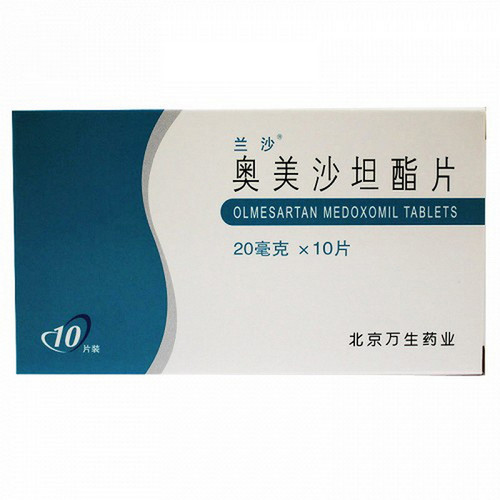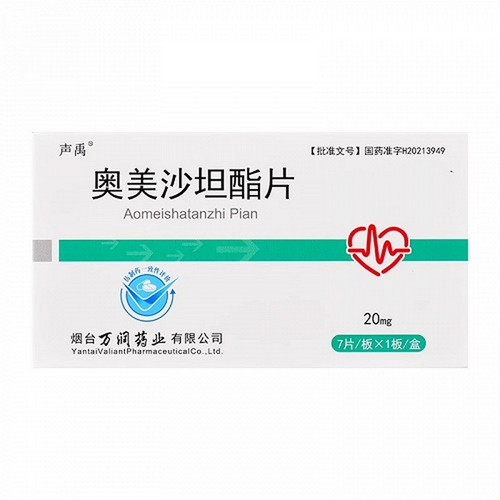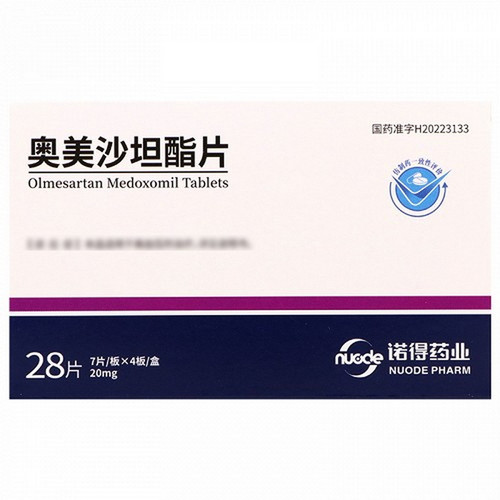Product Overview
[Drug Name]
Generic Name: Olmesartan Medoxomil Tablets
Trade Name: Lansha
English Name: Olmesartan Medoxomil Tablets
Chinese Pinyin: Aomeishatanzhi Pian
[Ingredients]
Olmesartan Medoxomil.
[Appearance]
This product is white or off-white tablets.
[Indications]
This product is indicated for the treatment of hypertension.
[Dosage and Administration]
The dosage should be individualized. As monotherapy in normovolemic patients, the recommended starting dose is 20 mg once daily. For patients who require further blood pressure lowering after two weeks of treatment, the dose can be increased to 40 mg. Doses greater than 40 mg have not demonstrated a greater antihypertensive effect. When the daily dose is the same, twice-daily dosing has not demonstrated superiority compared to once-daily dosing. This product can be taken with or without food. This product can be used in combination with other diuretics and other antihypertensive medications. Children: The pharmacokinetics of olmesartan have not been studied in children under 18 years of age. Elderly: Maximum plasma concentrations of olmesartan are similar in young adults and elderly adults (≥65 years). Mild accumulation of olmesartan was observed in elderly patients with multiple doses; the mean steady-state area under the concentration-time curve (AUCss) was 33% higher in elderly patients, corresponding to a 30% decrease in renal clearance (CLR). Hepatic Impairment: Both AUC0° and maximum plasma concentration (Cmax) were increased in patients with moderate hepatic impairment, with AUC increased by approximately 60%. Renal Impairment: The area under the concentration-time curve (AUC) after multiple doses in patients with severe renal impairment (creatinine clearance <20 ml/min) was approximately three times that of subjects with normal renal function. Patients undergoing hemodialysis have not been studied.
[Adverse Reactions]
The safety of olmesartan medoxomil was evaluated in controlled clinical trials involving up to 3275 patients, of whom approximately 900 received treatment for at least 6 months and more than 525 received treatment for 1 year. Results showed that Olmesartan medoxomil was well tolerated, with adverse event rates similar to those in the placebo group. Adverse events were generally mild and transient, and were not associated with dose, age, or race. In placebo-controlled clinical trials, the only adverse event with an incidence greater than 1% and higher in patients receiving Olmesartan medoxomil than in the placebo group was dizziness (3% vs. 1%). Adverse events with an incidence greater than 1% similar to placebo included back pain, bronchitis, increased creatine phosphokinase, diarrhea, headache, hematuria, hyperglycemia, hypertriglyceridemia, pharyngitis, rhinitis, and sinusitis. The incidence of cough was similar in patients in the placebo group (0.7%) and the Olmesartan medoxomil group (0.9%). Adverse events with an incidence rate similar to that of the placebo group, less than 1%, and greater than 0.5%, included chest pain, fatigue, pain, peripheral edema, dizziness, abdominal pain, dyspepsia, gastroenteritis, nausea, tachycardia, hypercholesterolemia, hyperlipidemia, hyperuricemia, arthralgia, arthritis, muscle pain, bone pain, rash, and facial edema. Whether these adverse events are related to this product is unclear. Laboratory Test Results: In controlled clinical trials, clinically significant changes in laboratory parameters were rarely associated with olmesartan medoxomil. Hemoglobin and hematocrit: Slight decreases in hemoglobin and hematocrit were occasionally observed (approximately 0.3 g/dL and 0.3 volume percentage, respectively). Liver function tests: Elevated liver enzymes and/or elevated blood bilirubin were occasionally observed, but these levels returned to normal spontaneously. Past market experience: There have been rare reports of rhabdomyolysis associated with angiotensin II receptor antagonists.
[Contraindications]
This product is contraindicated in patients with allergies to its ingredients.
[Precautions]
1. Renal Artery Stenosis: There have been reports that ACE inhibitors may increase serum creatinine or blood urea nitrogen (BUN) in patients with unilateral or bilateral renal artery stenosis. However, there is no experience with long-term use of this drug in such patients, but similar results may occur. 2. Renal Impairment: In patients whose renal function depends on the activity of the renin-angiotensin-aldosterone system (such as those with severe heart failure), the use of ACE inhibitors and AT1 receptor antagonists may cause oliguria and/or progressive azotocin-induced renal failure and/or death (rarely). Olmesartan medoxomil should be used for treatment of such patients. 3. Fetal/Neonatal Morbidity and Mortality: In pregnancy category D (trimester II and III), drugs that directly act on the renal artery system have been associated with fetal and neonatal harm. This drug should be discontinued as soon as pregnancy is detected. If medication is necessary, pregnant women should be informed of the potential risk to their fetus and undergo serial ultrasound examinations to assess the amniotic fluid. Infants who have been exposed to angiotensin II receptor antagonists in utero should be closely monitored for hypotension, oliguria, and hyperkalemia, and appropriate treatment should be administered if necessary. 4. Hypotension in Patients with Volume Depletion or Hyponatremia: Patients with volume depletion or hyponatremia (e.g., those receiving high-dose diuretics) may experience symptomatic hypotension after the first dose of this drug and must be treated with this drug under close medical supervision. If hypotension occurs, the patient should be placed in the supine position and, if necessary, intravenous saline should be administered. Once blood pressure stabilizes, treatment with this drug can be continued.
[Use in Special Populations]
Precautions for Use in Children:
This study has not been conducted and no reliable references are available. Safety and efficacy data for this drug in children have not been established.
Precautions for Use During Pregnancy and Lactation:
Drugs that directly act on the renin-angiotensin system can cause harm or even death to the developing fetus when used during the second and third trimesters. Once pregnancy is detected, this drug should be discontinued as soon as possible. There is currently no clinical experience with this drug in pregnant women. It is not known whether olmesartan medoxomil is excreted in breast milk, but small amounts are found in the milk of lactating rats. Because of potential adverse effects on nursing newborns, decisions to discontinue breastfeeding or discontinue the drug should be made, taking into account the importance of the drug to the mother.
Precautions for Elderly Patients:
In clinical trials, no overall differences in the efficacy or safety of this drug were observed between elderly and younger patients. No dose adjustment is required for elderly patients. However, the possibility of increased sensitivity in some older individuals cannot be ruled out.
[Drug Interactions]
Olmesartan medoxomil is not metabolized by the hepatic cytochrome P450 system and has no effect on P450 enzymes. Therefore, drug interactions related to inhibition, induction, or metabolism of these enzymes are unlikely. Concomitant use of digoxin or warfarin has not shown any significant drug interactions in healthy subjects, and concomitant use of antacids (Al(OH)3/Mg(OH)2) has not significantly altered the bioavailability of olmesartan medoxomil.
[Pharmacological Actions]
Angiotensin I (ATI) is converted to angiotensin II (ATII) by angiotensin-converting enzyme (ACE, kinase II). Angiotensin II is the primary pressor of the renin-angiotensin system. Its actions include vasoconstriction, stimulation of aldosterone synthesis and release, cardiac stimulation, and increased renal sodium reabsorption. Olmesartan medoxomil is a prodrug that is absorbed and hydrolyzed into olmesartan via the gastrointestinal tract. Olmesartan is a selective angiotensin II type 1 receptor (AT1) antagonist, inhibiting the vasoconstrictive effects of angiotensin II by selectively blocking its binding to AT1 receptors on vascular smooth muscle, thus acting independently of the AT2 synthesis pathway. Olmesartan has an affinity for AT1 that is over 12,500-fold greater than its affinity for AT2. Blocking the renin-angiotensin system (RAS) with ACE inhibitors is a mechanism of action for many antihypertensive drugs. However, ACE inhibitors also inhibit the degradation of bradykinin, whereas olmesartan medoxomil does not inhibit ACE and therefore does not affect bradykinin. The clinical relevance of this difference is unclear. Blockade of angiotensin II receptors inhibits the negative feedback regulation of angiotensin II on renin secretion. However, the resulting increase in plasma renin activity and circulating angiotensin II concentrations does not affect the antihypertensive effect of olmesartan.
[Storage] Store in a dark, sealed container.
[Specification] 7 tablets (20 mg)
[Packaging] Box
[Expiry Date] 12 months
[Approval Number] National Medicine Standard H20061312
[Manufacturer] Beijing Fuyuan Pharmaceutical Co., Ltd. (formerly Beijing Wansheng Pharmaceutical Co., Ltd.)









